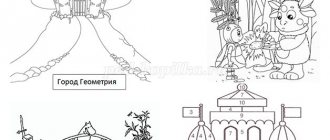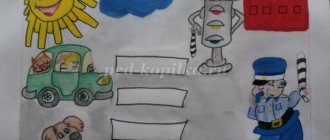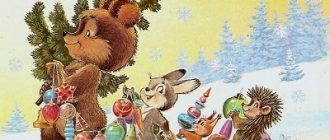presentation “About the Moon” presentation for a lesson on the world around us (senior group)
Slide 1
LUNA In the footnote of the first slide - additional information about Luna Elena Lenna
Slide 2
The Moon is the only satellite of our planet. The Moon revolves around the Earth in its own (elliptical) orbit. The Moon makes a full circle around the Earth in 29.5 days.
Slide 3
And the name “Moon” came to us from the ancient Romans. The ancient Greeks called the Moon Selene.
Slide 4
The diameter of the Moon is almost 4 times smaller than the diameter of the Earth.
Slide 5
If you look at the Moon from Earth, it looks like a small spotted ball, but with a telescope, or even with good binoculars, you can see that this is not so - there are mountains and many craters on the Moon.
Slide 6
Many years ago, the scientist Galileo Galilei called them seas. Now we already know that there are no seas on the moon, but according to tradition, the craters have retained their names. Many of them are unusual for the Earth - the Sea of Abundance, the Sea of Cold, the Sea of Rain, the Sea of Clarity, the Sea of Vapor. Smaller craters bear the names of famous people - Tycho Brahe, Copernicus, Ptolemy, Yuri Gagarin. Depressions in the surface of the Moon are called craters.
Slide 7
And these are the Moon Mountains. Their names are quite earthly - Caucasus, Altai, Carpathians, Alps, Apennines, Perinees, Tenerife. The height of the mountains can reach up to 8 km, but usually it is 3-5 km.
Slide 8
Look at how, according to scientists, the lunar craters were formed many years ago. Nowadays, new craters no longer form, because there are almost no large meteorites left in space. 1 . A meteorite is approaching. 2. It collides with the surface and forms a column of dust. 3. After the dust settles, it becomes clear that a dent has formed on the surface, and in its center there is a hill. 4 . Since there were still volcanoes on the Moon at that time, lava flows during eruptions filled the craters and they became less deep.
Slide 9
This is a small fragment of one of the meteorites.
Slide 10
Although the Moon rotates around its own axis, it does so very slowly—27.3 days. Almost during the same time it turns around the Earth. And since the directions of rotation coincide, it turns out that it is always turned to the Earth with only one side. This is the dark side of the Moon, never visible from Earth. People first saw the dark side of the Moon only in 1959, when the Luna 3 probe took pictures of it.
Slide 11
Sometimes we can observe a phenomenon called a lunar eclipse. It occurs when the Sun, Earth and Moon are on the same line and the Earth covers the Moon from the Sun with its shadow. An eclipse can be not only total, but also partial. In this case, the shadow of the Earth does not fall on the entire Moon, but only on a piece of it. A lunar eclipse can last up to 1 hour. Lunar eclipses
Slide 12
Phases of the Moon If you carefully observe the Moon for a month, you will notice that the Moon is always visible in different ways - sometimes a thin sickle, sometimes a round pancake. Sometimes its “ends” are directed in one direction, and sometimes in the other. These changes are called moon phases.
Slide 13
This photo shows the Moon very clearly at New Moon.
Slide 14
And here is the full moon
Slide 15
Under the crust there is a mantle and a small core. Its radius is about 340 km, and its mass is approximately 2% of the mass of the entire Moon. The Moon's mantle is not completely melted like the Earth's mantle. That's why there are no volcanoes on the Moon. This is what the structure of the Earth looks like. Yellow is molten magma inside the globe. Sometimes it breaks to the surface. People call it a volcanic eruption. The thickness of the lunar crust is about 60 km. Structure of the Moon Earth
Presentation for children 6–7 years old “Solar System”
Elena Babina
Presentation for children 6–7 years old “Solar System”
Relevance
Preschool age is a period of active entry into the period of learning about the world around us. Observing the celestial bodies has always been interesting to people at all times. Children are also attracted to this mysterious distance. Children show broad curiosity, ask questions regarding near and distant objects and phenomena, try to independently come up with explanations for natural phenomena, love to observe and experiment.
In order to preserve and develop curiosity in children , and enrich their experience of interacting with the world around them, I planned joint activities with objects and phenomena of space.
Goals:
Expand and form in preschool children the solar system and its planets .
Tasks:
— To form in children an idea of the solar system and planets ;
-Help to understand the sequence of planets as they move away from the sun ;
— Contribute to the development of cognitive interest;
-Expand vocabulary (star, solar system , planet, comet, meteorite)
.
Expected results of work on the topic “ Solar System ”
— development of cognitive interests, curiosity and motivation;
— formation of cognitive actions, formation of consciousness;
— development of imagination and creative activity;
— instilling in children a respectful attitude towards the work of other people;
- vocabulary expanded;
Description of practical significance
This presentation material will be useful to teachers of preschool educational institutions in the field of cognitive orientation of education for children 6-7 years old .
Collaborative activities between teachers and children
Area Cognition
Conversations with children:
" The sun is the source of life on Earth"
.Goal: to clarify
children’s knowledge about the sun , its shape;
explain what it consists of; What is space.” Purpose: to give children an idea of the planets of the solar system , the sun , stars, the first flight into space, to find out children’s knowledge on this issue ;
"Blue Planet - Earth"
.Goal: to explain to children what a telescope and outer space are, to show how beautiful our Earth is from space;
"The Moon is the Earth's satellite"
.Goal: to find out
children’s ideas about the Moon , expand knowledge about the lunar surface and atmosphere;
"Planets of the solar system "
Goal: expand
children's understanding of the planets of the solar system ;
"The first space explorers"
Goal: to tell children about animals that flew into space before humans;
“Who are astronauts?”
.Purpose: to introduce the biography of the first cosmonaut Yu. A. Gagarin; with the first woman cosmonaut V.V. Tereshkova to talk about the work of Russian cosmonauts in space these days.
Working on the theme “Space”
the preparatory group
children to form and expand their understanding of the solar system , constellations, meteorites, and to develop an interest in unknown facts from the history of space. The children learned to analyze existing facts, establish cause-and-effect relationships, and draw conclusions.
Program on the surrounding world “Green Path” for classes in preparation for school.
1)Target:
development in children of universal prerequisites for educational activity, cognitive processes and intellectual abilities; systematization and scientific correction of natural history ideas accumulated by children in preschool age.
Tasks:
Educational
- to form ideas about the flora and fauna, seasonal changes in nature, certain types of work and professions;
— clarify and systematize knowledge about natural phenomena;
— enrich active and passive vocabulary;
Developmental
- develop verbal and logical thinking, the ability to draw conclusions, justify your judgments;
- develop skills of self-control and self-esteem;
- develop the ability to understand a learning task and complete it independently;
- develop a sense of empathy and compassion for people around you;
- develop creativity and imagination;
— to develop general educational skills: the ability to work in a team, to bring the job started to completion, to work carefully and concentratedly.
Educational
- contribute to the education of hard work, kindness, responsiveness;
- contribute to the development of interest and love for the Motherland, nature, the ability to admire its beauty, treat plants and animals with care.
- formulate ethical standards and correct behavior.
2) Regulatory documents on the basis of which the program was developed:
Federal Law “On Education in the Russian Federation” No. 273-FZ dated December 29, 2012.
The concept of preschool education in the Educational System “School of Russia”;
SanPiN 2.4.1.3049-13;
Methodological recommendations for conducting classes in the main areas of cognitive activity of older preschoolers.
Order of the OU No. 246 dated October 1, 2014. “On the organization of paid additional educational services”
3) Information about the program:
The work program on the surrounding world was developed on the basis of the educational and methodological manual by A.A. Pleshakov “Green Path” and is intended for preparing children of senior preschool age and preparing for school. The program specifies the content of the subject topics of the educational standard, provides the distribution of training hours by sections of the course and the recommended sequence of studying topics and sections of the academic subject, taking into account interdisciplinary and intrasubject connections, the logic of the educational process, and the age characteristics of students.
4) Justification for choosing the program
The work program contributes to the preservation of a unified educational space, without hindering the creative initiative of the teacher, and provides ample opportunities for the implementation of various approaches to the construction of a curriculum, the formation of a system of knowledge, skills, methods of activity, the development and education of preschoolers. A distinctive feature of this program from existing ones is that preparation for school does not allow duplication of first-grade programs and focuses not on the level of knowledge, but on the development of the child’s potential capabilities, on his zone of proximal development. A special feature of school preparation is its integrated basis. The program not only aims to prepare the child for school, but is also developmental in nature, solving the problems of the general development of the future first-grader, his physical, social and mental functions necessary for systematic learning at school.
5) Information about changes made
No changes have been made to the sample program.
6) Information about the number of hours for which the work program is designed.
The program is based on 1 hour of study load per week (1 hour per week), throughout the entire academic year from October 1 to May 15 (30 hours).
Appendix 1 to the work program “Calendar-thematic plan” specifies the topics of each lesson and the dates of the lessons; main types of educational activities of students.
7) Forms of organization of the educational process
- group classes with children;
- individual consultations;
- activity-game;
- activity-travel;
- activity-research;
- activity-holiday;
- activity-performance;
- activity-competition;
- lesson-excursion;
- activity-competition.
- pair work
The assignments are focused on the use of group forms of learning. To complete this task, preschoolers must decide how they will act, distribute among themselves who will do what work, in what order or sequence, and how they will check the completion of the work. This type of task is very important, as it contributes to the formation of regulatory, communicative universal actions, provides the opportunity for each child to express his personal opinion, compare it with the opinions of others, figure out why I thought this way and my friend differently. Children learn different ways of receiving and processing information, “learning by teaching.”
 Educational technologies
Educational technologies
Standard pedagogical technologies are used in lessons:
developmental education (development of personality and its abilities)
differentiated training (creating optimal conditions for identifying inclinations, developing interests and abilities);
game training (ensuring personal and active character
acquisition of knowledge, skills, game methods of involvement in creative activities);
health-saving technologies (physical training sessions)
9) Types and forms of control
When mastering the course, initial and final diagnostics are provided, the purpose of which is to identify the level of mastery of the program. The results of a diagnostic examination of children are used to design the educational process. Test methods and diagnostic cards have been developed for this purpose. The selection of educational material is carried out taking into account the results of initial and intermediate diagnostics of children. At the end of the training course, a final diagnostic is carried out, in which the same test techniques are used, but the tasks in them are more complicated.
10) Planned level of training for preschoolers at the end of the school year
By the end of the school year, preschoolers will learn:
- basic rules of behavior in nature;
— the main features of the seasonal life of nature;
— about domestic animals (their benefits), about the life of wild animals;
— rules of safe behavior in the house and on the street; precautions when interacting with other people, household items, animals;
— about beauty in nature, art, everyday life, human relationships;
- about your good and bad habits, about the need for self-education.
- plants and animals of our area.
— safety rules when picking berries, medicinal plants, and mushrooms.
—
variety of birds and animals.
— safety rules when meeting and communicating with animals.
By the end of the school year, preschoolers will have the opportunity to learn:
- distinguish and name trees and shrubs;
- name mushrooms, distinguish between edible and poisonous mushrooms;
— follow the rules of behavior, avoiding dangerous situations;
- in case of danger, react correctly and seek help from others;
- show kindness to the people around you, acquaintances and strangers, without demanding anything in return;
- be a generous and honest person and value these qualities;
- see beauty in all its manifestations, strive for it;
- evaluate yourself and your actions, get rid of the bad and develop a positive image of your “I”.
- apply acquired knowledge and methods of activity to solve new cognitive problems; — show a cautious and prudent attitude towards potentially dangerous situations for humans, follow basic rules of road safety and safe behavior in the natural world; - show an interested and caring attitude towards the natural environment, observe the simplest rules of behavior in nature.
11)Information about the textbook
Pleshakov A.A. Green path. A textbook for preparing children for school. M.: Education. 2013




